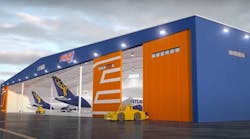The flying observatory SOFIA (Stratospheric Observatory for Infrared Astronomy) has arrived at Lufthansa Technik in Hamburg, Germany, for scheduled maintenance work. SOFIA is a modified Boeing 747SP and a joint project of the U.S. space agency NASA and the German Aerospace Center (DLR). The German SOFIA Institute (DSI) at the University of Stuttgart coordinates the operation of SOFIA on the German side. The aircraft will undergo a C-check by Lufthansa Technik's experts in the VIP and Special Mission Aircraft Services division.
A C-check is the biggest regularly scheduled maintenance event for an aircraft other than a complete overhaul. In the case of this special aircraft, the maintenance will be carried out in accordance with NASA regulations. During the check in Hamburg, the aircraft's structure will be thoroughly inspected and repaired, where necessary.
SOFIA was extensively modified for its scientific task, with special electronic systems being added as well as a four by six-meter door in the fuselage for the telescope. The aircraft is subject to high loads during operation. The work on SOFIA's additional pressure bulkhead, which was added when the aircraft was modified for use as an observatory, will be especially challenging, since various fixtures must be moved to access this bulkhead.
In 2014, SOFIA was scheduled for a major overhaul (D-check), which was also completed at Lufthansa Technik in Hamburg. "Then as now, Lufthansa Technik's extensive experience with Boeing 747SP aircraft was the decisive factor. We are glad to return the aircraft to the experienced hands of Lufthansa Technik," said Heinz-Theo Hammes, SOFIA project manager at DLR. Only few Boeing 747SP ("Special Performance") aircraft are still in service worldwide. In Europe, Lufthansa Technik is the only company certified to carry out technical work on this type of aircraft.
Eddie Zavala, NASA's program manager for SOFIA, added: "In 2014, we were extremely impressed with the high quality of work and expertise of the Lufthansa Technik personnel. Lufthansa Technik is the right organization to meet the special needs of the NASA/DLR partnership and provide integrated observatory maintenance on our uniquely modified and highly specialized 747SP aircraft. We look forward to continuing our teamwork with Lufthansa Technik."
"It's a very special opportunity for all of us to work on this outstanding and technologically sophisticated aircraft," said Sven Hatje, project manager at Lufthansa Technik. "We, too, look forward to the continued trustful cooperation with the representatives of NASA, DLR and the German SOFIA Institute (DSI) of the University of Stuttgart."
SOFIA:
SOFIA stands for Stratospheric Observatory For Infrared Astronomy. During its scientific flights, this unique flying observatory examines, among other things, black holes at the center of galaxies and how stars and planetary systems originate from interstellar molecules and dust clouds. The fuselage of the aircraft is fitted with a 17-ton telescope with a mirror diameter of 2.7 meters. While flying at altitudes of up to 14 kilometers, a door in the fuselage isopened for observations.
SOFIA is a joint project of Deutsches Zentrum für Luft- und Raumfahrte.V. (DLR, German Aerospace Center; grant: 50OK0901, 50OK1301 and 50 OK 1701) and the U.S. National Aeronautics and Space Administration (NASA). It is funded on behalf of DLR by the Federal Ministry of Economics and Energy based on legislation by the German parliament, the state of Baden-Wuerttemberg and the University of Stuttgart. Scientific operation of the aircraft is coordinated on the German side by the German SOFIA Institute (DSI) of the University of Stuttgart and on the American side by the Universities Space ResearchAssociation (USRA). More information: www.dlr.de/sofia



